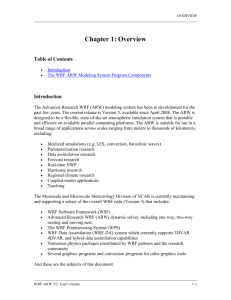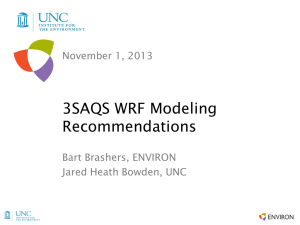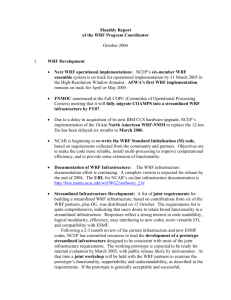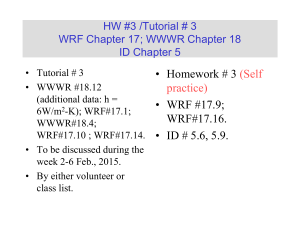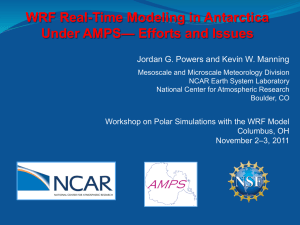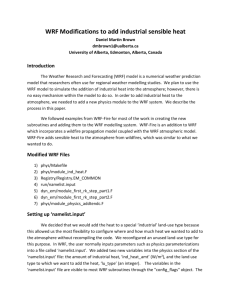WRF_Protocol_May29_2013v2
advertisement
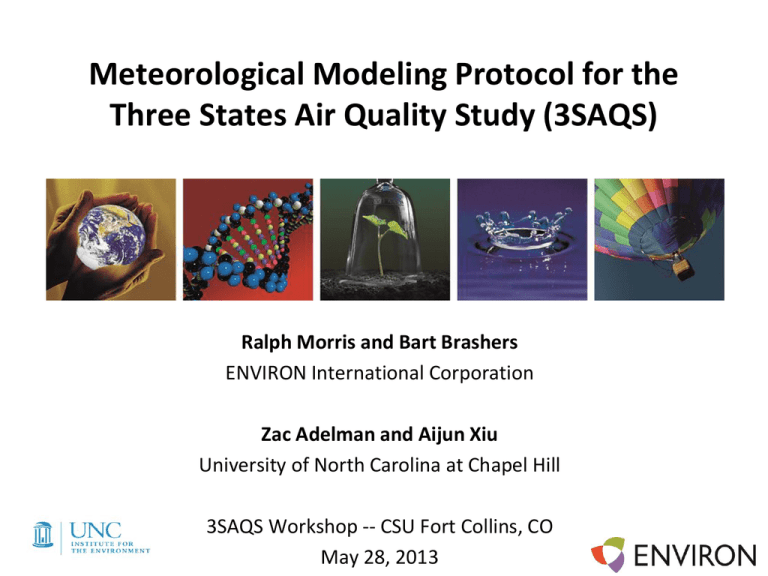
Meteorological Modeling Protocol for the Three States Air Quality Study (3SAQS) Ralph Morris and Bart Brashers ENVIRON International Corporation Zac Adelman and Aijun Xiu University of North Carolina at Chapel Hill Template 3SAQS Workshop -- CSU Fort Collins, CO May 28, 2013 Purpose • To perform prognostic meteorological modeling to support the development of Photochemical Grid Model (PGM) inputs – PGM modeling will analyze the air quality and air quality related values (AQRVs, which include visibility and sulfur and nitrogen deposition) at key receptor areas across the western U.S. • Goal is for 3SAQS PGM modeling to start in fall 2013 • To achieve this schedule requires the meteorological modeling process to start now 2 3SAQS Meteorological Modeling Leverages off of Several Recent Studies • Denver RAQC and CDPHE MM5 and WRF sensitivity modeling (ENVIRON & Alpine, Jun 2011) – Develop improved PGM modeling procedures for Denver area – Bridge between MM5 and WRF • WDEQ WRF modeling (Alpine & ENVIRON, Sep 2011) – 2008 annual 36/12 km and winter episode fine-scale • WestJumpAQMS 2008 36/12/4 km WRF modeling (ENVIRON & Alpine, Feb 2012) – Use as template for 3SAQS meteorological modeling – Update to more recent model options and procedures 3 3SAQS Meteorological Modeling Steps • Prepare Draft Modeling Protocol – Done – (ENVIRON and UNC, May 2013) • 3SAQS Cooperators Comment on Protocol • Finalize Modeling Protocol (Jun 2013) • Meteorological Modeling (Jun-Jul/Aug 2013) • Meteorological Model Application/Evaluation Report (Aug/Sep 2013) • PGM Meteorological Inputs (Sep 2013) 4 3SAQS Meteorological Modeling Protocol • Model Selection: WRF ARW Performing better than MM5 that is no longer supported • Episode Selection: 2011 – Corresponds to NEI year and not atypical AQ/Met • Domain Definition: 36/12/4 km – 36 km CONUS Domain (RPO, WestJumpAQMS, etc.) – 12 km WESTUS Domain (WestJumpAQMS) – 4 km Domain – Need Feedback from 3SAQS: Option 1: WestJumpAQMS 12 km Inter-Mountain West Processing Domain (IMWD) Option 2: Smaller 4 km domain tailored for 3SAQS 5 WestJumpAQMS 36/12/4 WRF Domain Modeling Domains 6 Alternative 3SAQS 36/12/4 km WRF Domain 7 36/12/4 km WRF Domain Definitions • RPO Lambert Conformal Projection – Center @ (40°, -97°) & true latitudes of 33° and 45° • 36 km CONUS Domain: ~165 x ~130 • 12 km WESTUS Domain: ~255 x ~255 • 4 km Domain Options: – WestJumpAQMS IMWD: ~325 x ~525 – Alternative: ~250 x ~290 (~half the size of the IMWD) 8 3SAQS 4 km WRF Domain Definition? • WJ WRF modeling w/ 4 km IMWD took 25,000 processing hours each 5-day segment using 8 cores – Elapsed time of ~100 days using 80 cores – Can 4 km domain focus on CO, UT and WY? 9 WRF Meteorological Model WRF Layer 37 36 35 34 33 32 31 30 29 28 27 26 25 24 23 22 21 20 19 18 17 16 15 14 13 12 11 10 9 8 7 6 5 4 3 2 1 Sigma 0.0000 0.0270 0.0600 0.1000 0.1500 0.2000 0.2500 0.3000 0.3500 0.4000 0.4500 0.5000 0.5500 0.6000 0.6400 0.6800 0.7200 0.7600 0.8000 0.8400 0.8700 0.8900 0.9100 0.9300 0.9400 0.9500 0.9600 0.9700 0.9800 0.9850 0.9880 0.9910 0.9930 0.9950 0.9970 0.9985 1.0000 Pressure (mb) 50.00 75.65 107.00 145.00 192.50 240.00 287.50 335.00 382.50 430.00 477.50 525.00 572.50 620.00 658.00 696.00 734.00 772.00 810.00 848.00 876.50 895.50 914.50 933.50 943.00 952.50 962.00 971.50 981.00 985.75 988.60 991.45 993.35 995.25 997.15 998.58 1000 Height (m) 19260 17205 15355 13630 11930 10541 9360 8328 7408 6576 5816 5115 4463 3854 3393 2954 2533 2130 1742 1369 1098 921 747 577 492 409 326 243 162 121 97 72 56 40 24 12 0 Thickness (m) 2055 1850 1725 1701 1389 1181 1032 920 832 760 701 652 609 461 440 421 403 388 373 271 177 174 171 84 84 83 82 82 41 24 24 16 16 16 12 12 WRF Vertical Domain • 37 vertical layers • Surface to 50 mb (~19 km • • • above msl) Layers 1 & 2 = 12 m thick each Max layer thickness = 2,000 m For PGM layer collapsing to 25 vertical layers? – Used in WJ, Denver, Allegheny Cty – Collapse 2 WRF layers in lowest 3 layers = 24, 32 and 40 – Max layer thickness = 3,900 m 10 3SAQS WRF Modeling Methodology • WRF Version 3.5 released August 18, 2013 • Model 2011 plus 15 day spin-up in Dec 2010 • Run in 5-day run segments from cold start – First 12 hours used to spin-up WRF • First guess fields and lateral BCs from either: – ERA-Interim Reanalysis from ECMWF; or – North American Model (NAM) archives Summer/winter sensitivity tests • USGS 24-category land use data 11 Four Dimensional Data Assimilation (FDDA) • 3-D Analysis Nudging on 36 and 12 km domains – Winds, Temperature and Mixing Ratio – No Temperature and Mixing Ratio in the PBL • Surface Observation Nudging in 4 km domain? – Meteorological Assimilation Data Ingest System (MADIS) observations Winds only NCDC surface observations NDBC overwater observations 12 WRF Physics Options WRF Treatment Microphysics Longwave Radiation Option Selected Thompson scheme RRTMG Shortwave Radiation RRTMG Land Surface Model (LSM) NOAH Planetary Boundary Layer (PBL) scheme YSU Cumulus parameterization Kain-Fritsch in the 36 km and 12 km domains, with KF trigger option 2 or 3. None in the 4 km domain. Nudging applied to winds, temperature and moisture in the 36 km and 12 km domains Nudging applied to surface wind only in the 4 km domain Analysis nudging Observation Nudging Initialization Dataset ERA-Interim Daily reanalysis product or 12 km NAM Notes New with WRF 3.1. Rapid Radiative Transfer Model for GCMs includes random cloud overlap and improved efficiency over RRTM. Same as above, but for shortwave radiation. Four-layer scheme with vegetation and sub-grid tiling. Yonsie University (Korea) Asymmetric Convective Model with non-local upward mixing and local downward mixing. 4 km can explicitly simulate cumulus convection so parameterization not needed. Temperature and moisture nudged above PBL only. Surface temperature and moisture observation nudging can introduce instabilities. WestJumpAQMS used 12 km North American Model (NAM) 13 WRF Model Performance Evaluation • Quantitative Evaluation – – – – Surface Temperature, Mixing Ratio and Winds Use METSTAT and AMET evaluation tools MADIS surface observation database 36, 12 and 4 km domains, subregions, individual states WestJumpAQMS went down to individual monitor • Qualitative Evaluation – Comparison of spatial patterns of precipitation with analysis fields based on observations (PRISM/CPC) – Comparison of spatial distribution of clouds with visual satellite observations 14 Model Performance Benchmarks • Met Model Performance Benchmarks originally derived after analysis of “good” MM5 performance to support air quality modeling (Emery et al., 2001) – Primarily ozone studies under simple (flat) terrain and simple meteorological conditions (e.g., stationary high pressure) Sometimes sea breezes involved (e.g., Houston and Los Angeles) • As part of WRAP, Kemball-Cook (2005) proposed alternative benchmarks to account for more complex conditions in the inter-mountain west and Alaska – McNally (2009) also proposed alternative benchmarks for complex terrain conditions 15 Model Performance Benchmarks Simple (Emery et al., 2001) and Complex (Kemball-Cook et al., 2005) Meteorological Model Performance Benchmarks Parameter Temperature Bias Temperature Error Mixing Ratio Bias Mixing Ratio Error Wind Speed Bias Wind Speed RMSE Wind Direction Bias Wind Direction Error Simple Complex ≤ ±0.5 K ≤ ±2.0 K ≤ 2.0 K ≤ 3.5 K ≤ ±1.0 g/kg NA ≤ 2.0 g/kg NA ≤ ±0.5 m/s ≤ ±1.5 m/s ≤ 2.0 m/s ≤ 2.5 m/s ≤ ±10 degrees NA ≤ 30 degrees ≤ 55 degrees 16 Soccer Plot Example Quantitative Evaluation • Temperature Bias vs. Error – 36 km CONUS, 12 km WESTUS & 4 km IMWD – Compared against Simple and Complex Benchmarks – From WestJumpAQMS 17 Example Qualitative Precipitation Evaluation Jan (top) and Jul (bottom ) CPC analysis fields (left) vs. WRF (right) 18 3SAQS WRF Modeling Next Steps • Decide on 4 km domain • Comments on Draft Modeling Protocol – By Monday June 10, 2013 • Start setting up WRF for 2011 modeling • Limited sensitivity tests – ERA ECMWF vs. NAM IC/BC – Other? • Need to initiate now to keep on schedule 19

